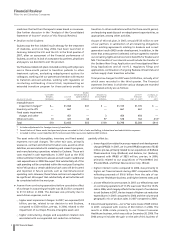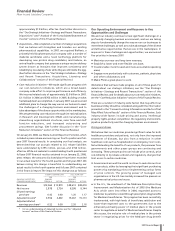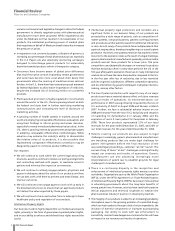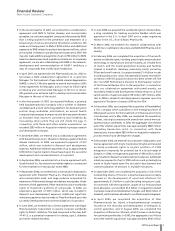Pfizer 2007 Annual Report Download - page 13
Download and view the complete annual report
Please find page 13 of the 2007 Pfizer annual report below. You can navigate through the pages in the report by either clicking on the pages listed below, or by using the keyword search tool below to find specific information within the annual report.
In addition, on a constant currency basis, we expect to achieve a
net reduction of the pre-tax total expense component of Adjusted
income of at least $1.5 billion to $2.0 billion, compared to 2006.
(For an understanding of Adjusted income, see the “Adjusted
Income” section of this Financial Review.)
As referenced in this section: (i) “current exchange rates” is
defined as rates approximating foreign currency spot rates in
January 2008 and (ii) “constant currency basis” is defined as the
actual foreign currency exchange rates in effect during 2006.
Given these and other factors, a reconciliation, at current exchange
rates and reflecting management’s current assessment, of 2008
Adjusted income and Adjusted diluted EPS guidance to 2008
reported Net income and reported diluted EPS guidance, follows:
FULL-YEAR 2008 GUIDANCE
(BILLIONS OF DOLLARS, EXCEPT PER-SHARE AMOUNTS) NET INCOME(a) DILUTED EPS(a)
Adjusted income/diluted EPS(b) guidance ~$ 15.8-$16.6 ~$2.35-$2.45
Purchase accounting impacts, net of tax (2.1) (0.31)
Costs related to cost-reduction initiatives,
net of tax (1.4-1.7) (0.21- 0.26)
Reported Net income/diluted EPS guidance ~$ 12.0-$13.1 ~$1.78-$1.93
(a) Excludes the effects of major business-development transactions
not completed as of December 31, 2007.
(b) For an understanding of Adjusted income, see the “Adjusted
Income” section of this Financial Review.
Our 2008 forecasted financial performance guidance is subject to
a number of factors and uncertainties—as described in the
“Forward-Looking Information and Factors That May Affect
Future Results” section of this Financial Review.
Accounting Policies
We consider the following accounting policies important in
understanding our operating results and financial condition. For
additional accounting policies, see Notes to Consolidated Financial
Statements—Note 1. Significant Accounting Policies.
Estimates and Assumptions
In preparing the consolidated financial statements, we use certain
estimates and assumptions that affect reported amounts and
disclosures. For example, estimates are used when accounting for
deductions from revenues (such as rebates, discounts, incentives
and product returns), depreciation, amortization, employee
benefits, contingencies and asset and liability valuations. Our
estimates are often based on complex judgments, probabilities and
assumptions that we believe to be reasonable, but that are
inherently uncertain and unpredictable. Assumptions may later
prove to be incomplete or inaccurate, or unanticipated events and
circumstances may occur that might cause us to change those
estimates or assumptions. It is also possible that other professionals,
applying reasonable judgment to the same facts and circumstances,
could develop and support a range of alternative estimated
amounts. We are also subject to other risks and uncertainties that
may cause actual results to differ from estimated amounts, such
as changes in the healthcare environment, competition, foreign
exchange, litigation, legislation and regulations. These and other
risks and uncertainties are discussed throughout this Financial
Review, particularly in the section “Forward-Looking Information
and Factors That May Affect Future Results.”
Contingencies
We and certain of our subsidiaries are involved in various patent,
product liability, consumer, commercial, securities, environmental
and tax litigations and claims; government investigations; and
other legal proceedings that arise from time to time in the
ordinary course of our business. Except for income tax
contingencies, we record accruals for contingencies to the extent
that we conclude their occurrence is probable and the related
damages are estimable, and we record anticipated recoveries
under existing insurance contracts when assured of recovery. For
tax matters, beginning in 2007 upon the adoption of a new
accounting standard, we record accruals for income tax
contingencies to the extent that we conclude that a tax position
is not sustainable under a ’more likely than not’ standard and we
record our estimate of the potential tax benefits in one tax
jurisdiction that could result from the payment of income taxes
in another tax jurisdiction when we conclude that the potential
recovery is more likely than not. (See Notes to Consolidated
Financial Statements—Note 1D. Significant Accounting Policies:
New Accounting Standards and Note 8E. Taxes on Income: Tax
Contingencies.) We consider many factors in making these
assessments. Because litigation and other contingencies are
inherently unpredictable and excessive verdicts do occur, these
assessments can involve a series of complex judgments about
future events and can rely heavily on estimates and assumptions
(see Notes to Consolidated Financial Statements—Note 1B.
Significant Accounting Policies: Estimates and Assumptions).
Acquisitions
Our consolidated financial statements and results of operations
reflect an acquired business after the completion of the acquisition
and are not restated. We account for acquired businesses using the
purchase method of accounting, which requires that the assets
acquired and liabilities assumed be recorded at the date of
acquisition at their respective fair values. Any excess of the purchase
price over the estimated fair values of the net assets acquired is
recorded as goodwill. Amounts allocated to acquired IPR&D are
expensed at the date of acquisition. When we acquire net assets that
do not constitute a business under generally accepted accounting
principles in the U.S. (U.S. GAAP), no goodwill is recognized.
The judgments made in determining the estimated fair value
assigned to each class of assets acquired and liabilities assumed,
as well as asset lives, can materially impact our results of
operations.
There are several methods that can be used to determine the fair
value of assets acquired and liabilities assumed. For intangible
assets, including IPR&D, we typically use the “income method.”
This method starts with our forecast of all of the expected future
net cash flows. These cash flows are then adjusted to present value
by applying an appropriate discount rate that reflects the risk
factors associated with the cash flow streams. Some of the more
significant estimates and assumptions inherent in the income
method or other methods include: the amount and timing of
projected future cash flows; the amount and timing of projected
costs to develop the IPR&D into commercially viable products; the
discount rate selected to measure the risks inherent in the future
cash flows; and the assessment of the asset’s life cycle and the
competitive trends impacting the asset, including consideration
2007 Financial Report 11
Financial Review
Pfizer Inc and Subsidiary Companies
























